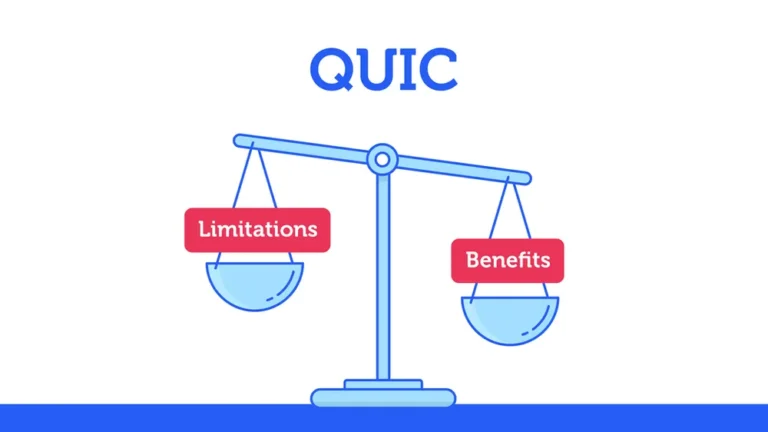
What is QUIC?
QUIC stands for “Quick UDP Internet Connections,” and it is a network protocol developed by Google. QUIC is designed to improve the performance and security of internet communications, particularly for web traffic. It was first proposed by Google in 2012 and is now an official internet standard known as “HTTP/3” (Hypertext Transfer Protocol version 3), as it typically carries HTTP traffic.
The primary goals of QUIC are to reduce latency, improve security, and optimize performance compared to the traditional Transmission Control Protocol (TCP) and Hypertext Transfer Protocol (HTTP) stack.
It achieves these goals through several key features:
Multiplexing: QUIC supports concurrent streams over a single connection, enabling multiple requests and responses to be processed in parallel. This multiplexing reduces the delay caused by the slow-start phase in TCP connections.
Connection Establishment: QUIC uses a faster handshake process compared to TCP. This reduces the time required to establish a connection, allowing for quicker access to content.
Error Correction: QUIC includes built-in forward error correction, which helps recover lost or corrupted data without the need for retransmission, improving reliability and reducing latency.
UDP-based: Unlike TCP, which relies on the transport protocol, User Datagram Protocol (UDP) is used as the underlying transport for QUIC. UDP is connectionless and provides reduced overhead, making QUIC more efficient.
Encryption: QUIC mandates encryption for all communications by default, promoting a secure web environment.
Connection Migration: QUIC supports connection migration, allowing clients to switch between different networks or IP addresses without interrupting the connection.
How Can QUIC Benefit Business?

The QUIC protocol can bring several benefits to businesses that rely on internet communications and web applications.
Here are some notable ways in which QUIC can be beneficial to any business:
Improved Website Performance: QUIC’s multiplexing and faster connection establishment significantly reduce latency and connection setup times. This means that web pages load faster, leading to better user experiences and potentially higher customer retention and engagement.
Enhanced Security: QUIC mandates encryption for all data transmitted, making it inherently more secure than traditional TCP-based protocols. By using QUIC, businesses can ensure that sensitive information, such as user credentials and payment details, are better protected against eavesdropping and man-in-the-middle attacks.
Mobile App Performance: Mobile applications often suffer from network latency and unreliable connections. With QUIC, the connection setup time is reduced, and packet loss recovery is more efficient. This translates into smoother mobile app experiences, which can be critical for businesses relying on mobile apps to reach their customers.
Connection Resilience: QUIC’s ability to migrate connections between different networks and IP addresses allows for better resilience in the face of changing network conditions. If a user moves from a Wi-Fi network to a cellular network, the connection can be seamlessly maintained, minimizing disruptions in service.
Increased User Engagement: Faster loading times and reduced waiting periods can improve user engagement with web applications, leading to higher conversion rates and improved customer satisfaction.
Better Video Streaming: For businesses that rely on video streaming services, QUIC can enhance the quality of the streaming experience. Its error correction capabilities help ensure smoother playback by reducing buffering and eliminating stuttering caused by packet loss.
Cost Savings: While the initial adoption of new protocols may require some investment, the improved efficiency and reduced latency offered by QUIC can lead to cost savings in the long run. Faster website loading times can reduce server and bandwidth costs, and improved user experiences can lead to more satisfied customers and increased revenue.
Competitive Advantage: Early adoption of QUIC can give businesses a competitive advantage over competitors that have not yet implemented the protocol. By offering a faster, more secure, and reliable online experience, businesses can differentiate themselves in the market and attract more customers.
It’s important to note that the benefits of QUIC can vary depending on the specific use case and network environment. However, as QUIC becomes more widely supported and standardized, its advantages for businesses are expected to become increasingly significant.
Will QUIC replace TCP?

While QUIC offers significant advantages over TCP in terms of performance, security, and reliability, it is not expected to completely replace TCP. Instead, it is likely to coexist and complement TCP in the internet protocol ecosystem. Here’s why:
Compatibility: TCP has been a fundamental part of the internet for decades, and it is deeply ingrained in networking infrastructure and applications. Many existing services and applications are built around TCP, and replacing it entirely would be a massive undertaking.
Legacy Support: There are numerous devices, applications, and systems that only support TCP and may not have the capability to adopt QUIC. As a result, TCP will likely continue to be used to ensure compatibility with these legacy systems.
Specific Use Cases: TCP is still highly suitable for certain use cases, such as long-lived connections where reliability is paramount, like file transfers or real-time communications. For these scenarios, TCP’s extensive reliability mechanisms are advantageous.
Network Infrastructure: TCP is deeply integrated into routers, switches, and other networking equipment. These devices would need to be updated or replaced to fully support QUIC, which would be a time-consuming and expensive process.
Network Environment: In some restrictive network environments, firewalls or proxies may not be optimized to handle QUIC traffic, leading to potential compatibility issues. As a result, organizations may continue to rely on TCP in such cases



